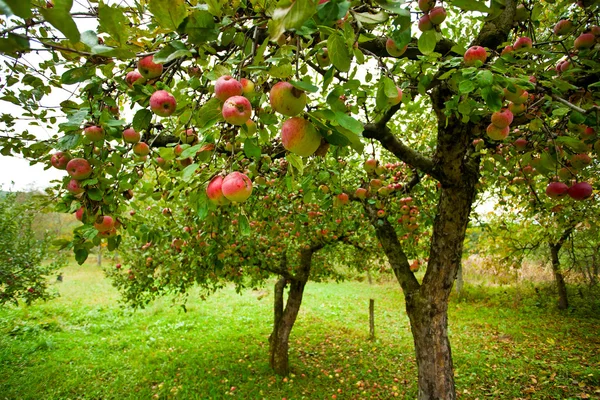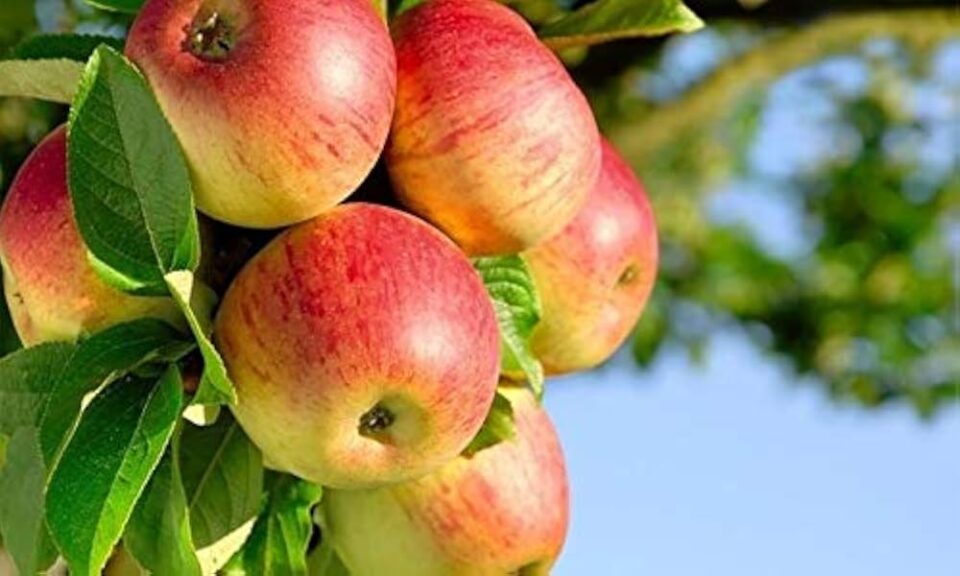Stepovers are a form of apple tree training that combines utility, beauty, and practicality in a way that works for almost any size of garden. The practice of growing stepover apple trees allows you to enjoy homegrown fruit while also enhancing the aesthetic appeal of your garden landscape. However, choosing the right stepover apple tree for your garden involves a bit of planning, understanding your space, and selecting the most suitable varieties.
Stepover apple trees, with their short stature and horizontal growth, are particularly appealing for those with limited space or those who wish to create a charming and productive border along paths or flower beds. Their low-growing habit makes them ideal for accessibility and decoration, and their flexibility means they can work in many different garden styles. Whether you’re a seasoned gardener or considering taking the leap to buy fruit trees for the first time, stepover apples are a wonderful choice for both beauty and productivity.
A nursery specialist from CRJ Fruit Trees comments, “Stepovers are a versatile and rewarding choice for home gardeners, offering both practicality and decorative charm. When choosing the right stepover, understanding rootstock, space requirements, and the apple variety’s growing needs will ensure your success.” This insight emphasises the importance of considering a range of factors before making your selection, which we will explore in detail throughout this article.
What Are Stepover Apple Trees?
Stepover apple trees are a type of trained apple tree that grows horizontally, typically just 30-45 cm off the ground. They are usually grown on dwarfing rootstocks, which restrict their growth, ensuring that the tree remains small and manageable. This training method involves carefully bending and tying the branches to create a horizontal form, which not only keeps the tree compact but also makes it highly decorative, perfect for lining paths, driveways, or flower beds.
Originally developed as a way to maximise growing space, stepover trees are a great solution for anyone wanting to incorporate apple trees into a small or already full garden. They can be used as living borders, framing garden beds or dividing different sections of a garden while still providing a harvest of apples. Their low height also makes them easy to maintain, and the fruits are within easy reach, making picking a straightforward and enjoyable task.
Stepovers are ideal for creating an orderly and visually appealing garden structure. Their controlled shape and size mean they won’t overshadow other plants, and they work beautifully alongside both ornamental flowers and other productive crops. Moreover, because they are grown on dwarfing rootstocks, they are easier to care for compared to standard or semi-dwarf trees, which can grow too large for small garden spaces.
Why Choose Stepover Apple Trees?
The decision to grow stepover apple trees comes with numerous benefits. For gardeners who value aesthetic beauty alongside productivity, stepovers offer a delightful combination of both. They make for attractive borders that provide seasonal interest, thanks to their spring blossoms, lush green leaves, and autumn fruit. Their form, which resembles low hedges, creates definition in the garden, adding visual structure and texture without taking up much space.
Another key advantage of stepover apple trees is their suitability for smaller spaces. Unlike larger apple trees that can require significant amounts of space and extensive pruning, stepovers are designed to remain compact and are easier to manage. They are also a great option for those new to fruit growing or for anyone who might feel overwhelmed by the demands of larger trees.
For gardeners interested in creating a variety of planting options, stepover apple trees can fit into garden beds alongside herbaceous perennials, vegetables, or flowers, making them a truly versatile choice. This is especially beneficial if you are looking to buy fruit trees that can enhance an already established garden without causing overcrowding.
Selecting the Right Rootstock

Choosing the right rootstock is one of the most important steps in ensuring the success of your stepover apple tree. Rootstocks determine the eventual size of the tree, its vigour, and its resistance to certain soil conditions. For stepovers, dwarfing rootstocks are the best choice as they help keep the tree manageable and maintain its horizontal form without requiring excessive pruning.
The most common rootstock used for stepover apple trees is the M27, which is a very dwarfing rootstock. It restricts the size of the tree to ensure that it remains small and suitable for growing as a stepover. M9 is another popular rootstock for this purpose, offering slightly more vigour than M27 but still keeping the tree small enough for training. If you are growing your stepover tree in less ideal conditions, such as heavier soil or a more exposed position, M9 may provide the added strength needed to thrive.
Rootstock selection is crucial because it affects not only the size of the tree but also its ability to thrive in different soil types and climates. Consulting with a knowledgeable nursery can help determine the best rootstock for your garden, based on your soil type and the growing conditions in your area. This is particularly important if you plan to buy fruit trees online, where you may need additional information about the suitability of different rootstocks for your specific environment.
Choosing the Right Apple Variety
The next step in selecting the right stepover apple tree is choosing the apple variety itself. The choice of apple variety will depend on several factors, including your personal taste preferences, the time of year you would like to harvest, and whether you are interested in eating apples, cooking apples, or a dual-purpose variety.
For those looking for a classic British eating apple, varieties like ‘Egremont Russet’ or ‘Cox’s Orange Pippin’ are popular choices. ‘Egremont Russet’ is known for its nutty flavour and firm texture, while ‘Cox’s Orange Pippin’ offers a complex and aromatic taste, ideal for fresh eating. For those who prefer cooking apples, the ‘Bramley’s Seedling’ is a well-known choice, prized for its tart flavour and suitability for baking and preserving.
When choosing the apple variety, it is also important to consider pollination requirements. Apple trees are not self-fertile, meaning they need another compatible variety nearby to ensure good pollination and fruit set. If you are only planting a single stepover, make sure there are other apple trees in the vicinity, or opt for a self-fertile variety like ‘Red Windsor,’ which can set fruit without a pollination partner. Ensuring proper pollination will maximise the yield from your stepover apple trees.
Another consideration is disease resistance. Some apple varieties are more resistant to common diseases like scab or powdery mildew, which can be beneficial if you prefer a low-maintenance approach to gardening. Varieties like ‘Red Falstaff’ and ‘Discovery’ are known for their disease resistance, making them good options for those who wish to reduce the need for chemical treatments.
Planting Stepover Apple Trees
Once you have selected the rootstock and apple variety, the next step is planting your stepover apple tree. The ideal time for planting is during the dormant season, typically between November and March, although container-grown trees can be planted at any time of year provided the soil is not frozen or waterlogged.
Stepovers should be planted in well-drained soil, in a position that receives plenty of sunlight—at least six hours of direct sunlight a day is recommended. The planting site should be prepared by removing any weeds and digging a hole wide enough to accommodate the root system without bending or crowding the roots. The tree should be planted at the same depth it was growing in the pot or nursery, with the graft union above the soil level.
After planting, it is important to install a support system to train the stepover apple tree into its characteristic horizontal shape. A simple wooden framework or a series of horizontal wires set at a height of around 30-45 cm from the ground works well. As the tree grows, its main stem is tied to the support, encouraging it to grow horizontally. This training helps shape the tree and maintains its low-growing form, which is essential for the visual and practical purposes of stepovers.
Watering is particularly important during the first year, as the tree establishes its root system. Ensuring the soil remains moist but not waterlogged will help the tree establish well. Mulching around the base of the tree with organic matter can help retain moisture and suppress weeds, but care should be taken to keep the mulch away from the trunk to prevent rot.
Training and Pruning Stepovers
Pruning and training are critical aspects of maintaining a stepover apple tree. Unlike standard apple trees, which grow vertically, stepovers require regular attention to maintain their horizontal form. The initial training process involves tying the main stem to the horizontal support and then removing any shoots that grow vertically from the main branch. This helps the tree maintain its desired shape and ensures that energy is directed towards fruit production rather than excessive vertical growth.
Pruning should be done during the winter when the tree is dormant. The main aim is to maintain the horizontal shape by removing any unwanted vertical shoots and encouraging the growth of fruiting spurs along the main stem. In summer, light pruning can be carried out to control excessive vegetative growth and ensure that light reaches all parts of the tree, which helps with fruit ripening and overall tree health.
Harvesting and Maintaining Tree Health
Harvesting from stepover apple trees is a straightforward and enjoyable process, thanks to their low height and easy accessibility. Depending on the variety you have chosen, apples will be ready for harvest from late summer through to autumn. Eating apples are best picked when they come away easily from the branch and are firm and aromatic, while cooking apples are generally harvested a little earlier, depending on their intended use.
Preventing pests and diseases from affecting your stepover apple tree is an important part of tree maintenance. Aphids and codling moths are frequent pests, and powdery mildew and apple scab are prevalent illnesses. In order to detect issues early and intervene promptly, it is recommended to examine the leaves, branches, and fruit on a regular basis. Safe pest management practices for trees and the environment can be achieved by the use of beneficial insects or insecticidal soaps, for example, on aphids.
Feeding your stepover apple tree with a balanced fertiliser in early spring will promote healthy growth and good fruit production. In addition, applying well-rotted manure or compost around the base of the tree helps improve soil structure and fertility, providing the nutrients needed for healthy fruiting.
Integrating Stepover Apple Trees into Your Garden Design
Stepovers are not only practical for fruit production but also highly decorative, making them a versatile addition to any garden design. They can be used as low hedges along pathways, as edging for flower beds, or even to separate different areas of the garden. Their low profile makes them ideal for adding interest without overshadowing other plants, and they work well in both formal and informal garden settings.
Integrating stepover apple trees into your garden can also enhance biodiversity. The blossoms attract pollinators such as bees, while the ripe fruit provides food for birds and other wildlife. This makes them an excellent choice for gardeners who are looking to create a garden that is both productive and supportive of local biodiversity.
Conclusion: A Delightful Choice for Every Gardener
Choosing the right stepover apple tree involves a combination of selecting the right rootstock, the appropriate variety, and understanding the planting and care requirements. Stepover apple trees provide a unique opportunity to grow apples in a way that is both productive and aesthetically pleasing, making them an ideal choice for those who wish to buy fruit trees that fit into small or well-curated garden spaces.
Their compact size, ease of care, and decorative potential make stepovers suitable for a wide range of gardening situations, from lining a path in a cottage garden to forming the perfect border in a modern outdoor space. By choosing the right variety and providing proper care, stepover apple trees can offer a bountiful harvest of delicious fruit, all while enhancing the beauty and structure of your garden. With their combination of practicality and charm, stepovers are a rewarding addition to any home garden, bringing both beauty and sustenance for years to come.

